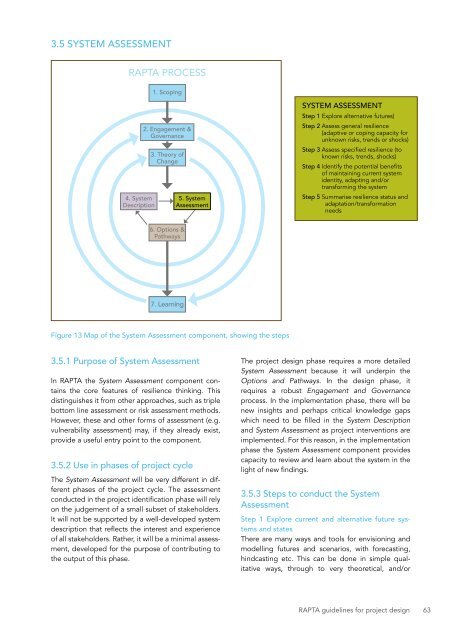DESIGNING PROJECTS IN A RAPIDLY CHANGING WORLD
srun3013fp1
srun3013fp1
You also want an ePaper? Increase the reach of your titles
YUMPU automatically turns print PDFs into web optimized ePapers that Google loves.
3.5 SYSTEM ASSESSMENT<br />
RAPTA PROCESS<br />
1. Scoping<br />
4. System<br />
Description<br />
2. Engagement &<br />
Governance<br />
3. Theory of<br />
Change<br />
5. System<br />
Assessment<br />
SYSTEM ASSESSMENT<br />
Step 1 Explore alternative futures)<br />
Step 2 Assess general resilience<br />
(adaptive or coping capacity for<br />
unknown risks, trends or shocks)<br />
Step 3 Assess specified resilience (to<br />
known risks, trends, shocks)<br />
Step 4 Identify the potential benefits<br />
of maintaining current system<br />
identity, adapting and/or<br />
transforming the system<br />
Step 5 Summarise resilience status and<br />
adaptation/transformation<br />
needs<br />
6. Options &<br />
Pathways<br />
7. Learning<br />
Figure 13 Map of the System Assessment component, showing the steps<br />
3.5.1 Purpose of System Assessment<br />
In RAPTA the System Assessment component contains<br />
the core features of resilience thinking. This<br />
distinguishes it from other approaches, such as triple<br />
bottom line assessment or risk assessment methods.<br />
However, these and other forms of assessment (e.g.<br />
vulnerability assessment) may, if they already exist,<br />
provide a useful entry point to the component.<br />
3.5.2 Use in phases of project cycle<br />
The System Assessment will be very different in different<br />
phases of the project cycle. The assessment<br />
conducted in the project identification phase will rely<br />
on the judgement of a small subset of stakeholders.<br />
It will not be supported by a well-developed system<br />
description that reflects the interest and experience<br />
of all stakeholders. Rather, it will be a minimal assessment,<br />
developed for the purpose of contributing to<br />
the output of this phase.<br />
The project design phase requires a more detailed<br />
System Assessment because it will underpin the<br />
Options and Pathways. In the design phase, it<br />
requires a robust Engagement and Governance<br />
process. In the implementation phase, there will be<br />
new insights and perhaps critical knowledge gaps<br />
which need to be filled in the System Description<br />
and System Assessment as project interventions are<br />
implemented. For this reason, in the implementation<br />
phase the System Assessment component provides<br />
capacity to review and learn about the system in the<br />
light of new findings.<br />
3.5.3 Steps to conduct the System<br />
Assessment<br />
Step 1 Explore current and alternative future systems<br />
and states<br />
There are many ways and tools for envisioning and<br />
modelling futures and scenarios, with forecasting,<br />
hindcasting etc. This can be done in simple qualitative<br />
ways, through to very theoretical, and/or<br />
RAPTA guidelines for project design 63


